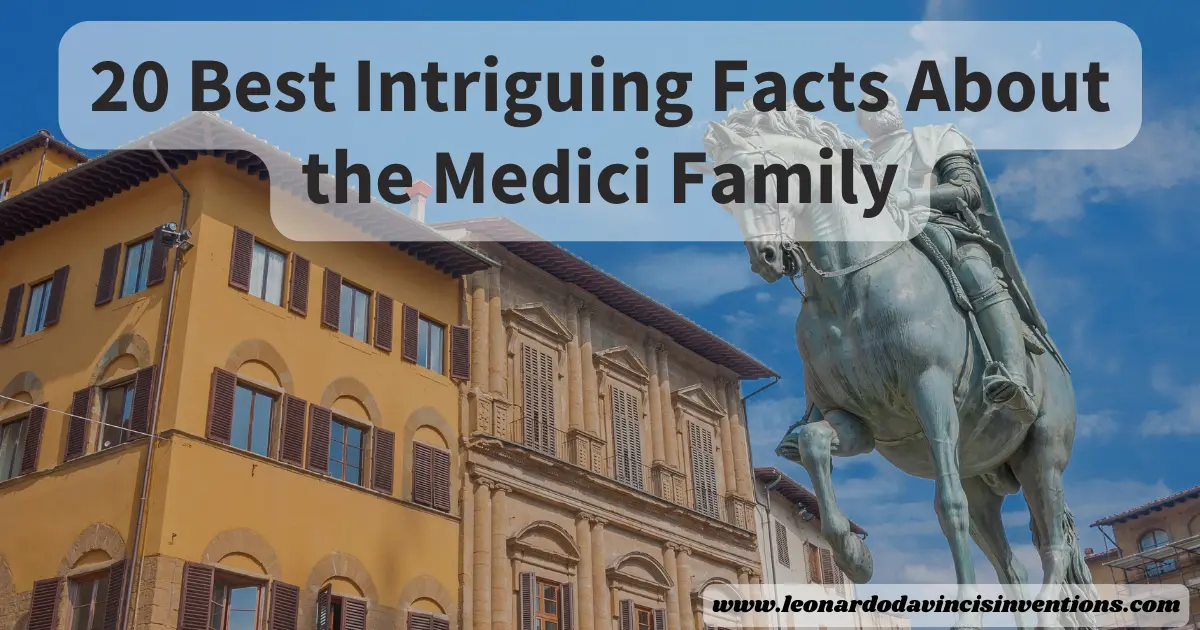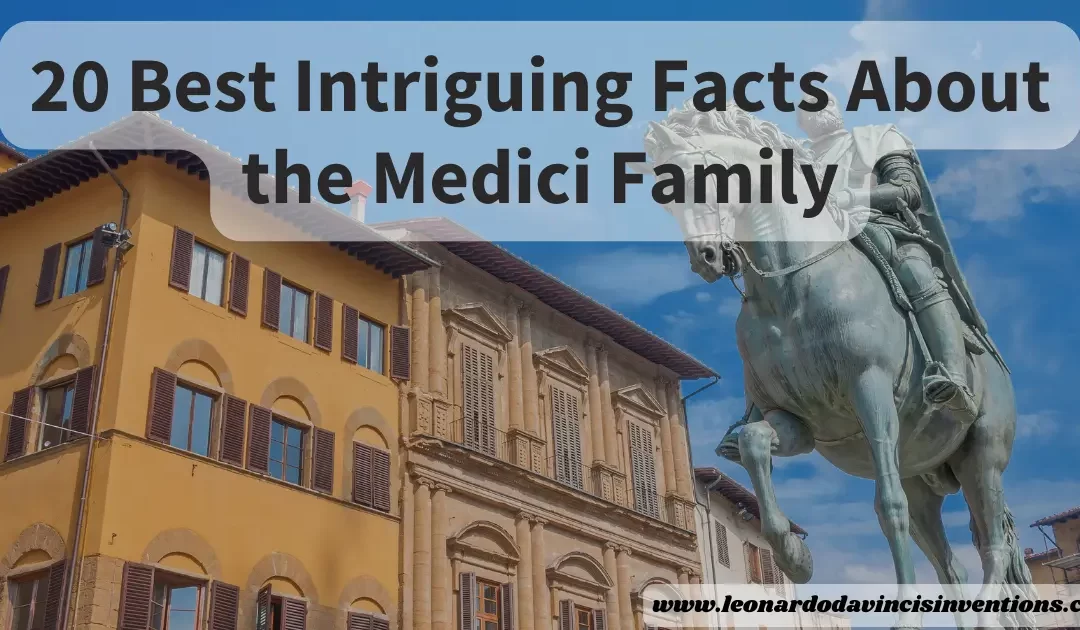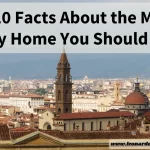
Medici family facts often seem complex and challenging to remember. This guide will help clear things up if you feel overwhelmed by names, dates, and stories.
You will discover clear and interesting facts about the Medici family that make their history easy to follow.
The Medici family shaped Florence and much of Europe for centuries. Surprisingly, their story connects art, politics, science, and religion.
These facts illuminate why the Medici are still studied and admired today.
1. The Medici family originated as merchants from the Mugello region north of Florence.
The Medici family began as merchants in the fertile Mugello region, just north of Florence, Italy. Their roots in trade and commerce laid the groundwork for the wealth that fueled their influence over Florence during the Renaissance’s peak.
Initially, the Medici were simple traders and bankers, rather than nobles. Over time, their banking empire expanded, granting them the power and resources to influence the culture and politics of Florence.
Their commercial success helped the Medici family gain respect. They also influenced the building of strategic alliances through marriage and became a leading political dynasty.
This foundation was crucial for their later roles as patrons of the arts, science, and architecture that defined Renaissance Florence.
2. They established the Medici Bank, once Europe’s most powerful financial institution.
The Medici Bank stood at the center of Renaissance Florence, Italy. Giovanni di Bicci de’ Medici founded it in 1397, and it became a crucial component in the family’s ascent to power.
The bank gained fame for its wealth, meticulous management, and strong family leadership. Under Cosimo the Elder, the bank expanded across Europe, opening branches in Rome, Venice, and London.
The Medici gained influence, and their extensive banking network helped them become rulers of Florence and major patrons of the arts and sciences. The Medici Bank’s success enabled the family to support artists such as Michelangelo and Leonardo da Vinci.
Their support shaped Renaissance culture and left a legacy that is still evident in Florence today. The Medici dynasty set the standard for banking and patronage in Europe.
3. Cosimo de’ Medici was the first to consolidate Medici power in Florence.
Cosimo de’ Medici transformed the Medici family from a wealthy banking family into a powerful political dynasty in Florence, Italy. As head of the Medici Bank, he expanded its reach and increased the family’s wealth.
He built alliances with other nobles and politicians, gaining great influence in Renaissance Florence. Cosimo used his position to shape the city’s government and culture.
He became a strong patron of the arts by supporting artists, architects, and scholars. This support helped Florence become a center for art and learning.
Cosimo de’ Medici’s leadership set the stage for later family members, including Lorenzo the Magnificent. His efforts established the Medici as rulers of Florence and central figures in Italian history.
4. The Medici ruled Florence for approximately 300 years during the Renaissance.
The Medici ruled Florence for around 300 years. Their rise to power began in the late 13th century and lasted until the 18th century.
Florence emerged as one of Europe’s most significant cultural centers during this period. The Medici family began as bankers, utilizing the Medici Bank to accumulate wealth and exert political influence.
With their wealth, they supported artists such as Michelangelo, Leonardo da Vinci, and Botticelli, fueling a burst of creativity known as the Renaissance. This political dynasty acted as patrons of art, science, and learning.
Medici support helped build landmarks like the dome of Florence Cathedral and funded public works and architecture that defined the city.
5. They were not hereditary nobles but rose to power through finance and politics.
The Medici family did not start as hereditary nobles. Instead, this powerful dynasty in Florence, Italy, built its wealth and influence through banking and trade during the Renaissance.
The Medici Bank became one of the most successful financial institutions in Europe. This banking empire gave the family the wealth and influence to gain political control over Florence.
Using their wealth, they influenced government decisions and formed strategic alliances through marriage. Their rise demonstrated that financial acumen and political savvy could be just as crucial as noble birth in gaining power in Renaissance Florence.
6. Giovanni di Bicci de Medici founded the Medici Bank in the late 14th century.
Giovanni di Bicci de Medici founded the famous Medici Bank in 1397 in Florence, Italy. This move began the Medici family’s economic rise and laid the groundwork for their enduring political dynasty.
At the time, Florence was one of the busiest cities in Europe for trade and banking. Thanks to wise management and strong family ties, the Medici Bank became Europe’s largest and most respected bank during the 1400s.
This brought great wealth and influence to the Medici family. The success of the Medici Bank contributed significantly to the flourishing of arts, science, and architecture in Renaissance Florence.
It helped the family become rulers of Florence and influential patrons of the arts and culture.
7. The family pioneered the development of formal rules and contracts for banking and lending.
The Medici family set new standards for banking in Renaissance Florence. They created the Medici Bank, which became the most respected financial institution in Europe at the time.
Before the Medici, Italian banking lacked official guidelines and clear systems. The Medici family introduced written rules and formal bank loan contracts, changing how people conducted business.
Their system helped build client trust and encouraged more people to use banks. These changes gave the Medici dynasty even more power in politics and economics.
Their approach to banking profoundly influenced systems across Europe and played a significant role in the growth and prosperity of Renaissance Florence.
8. Lorenzo de Medici, known as ‘Lorenzo the Magnificent’, was a major patron of Renaissance art.
Lorenzo the Magnificent was a leading figure in the Medici political dynasty. He ruled Florence, Italy, and played a pivotal role in shaping its cultural transformation during the Renaissance.
He supported many artists, poets, and scholars. Famous artists such as Michelangelo and Botticelli gained their start thanks to Lorenzo’s generous patronage.
His funding and encouragement helped make Florence a center for art and learning. Lorenzo’s influence can still be seen in Renaissance art and architecture across Florence.
The Medici family’s wealth from banking enabled it to sponsor painters, sculptors, and architects, transforming the city’s appearance and spirit. His support for public works, libraries, and collections helped build a lasting legacy of creativity and education.
9. The Medici family crest, featuring balls called ‘palle’, is visible throughout Florence.
The Medici family crest, marked by its iconic red balls known as “palle,” appears on buildings, churches, and monuments throughout Florence. This shield features five red balls and one blue ball, and became a strong symbol of the Medici dynasty’s influence and wealth during the Renaissance.
Many historians believe the balls on the Medici coat of arms may represent coins, a reminder of the family’s success in banking and finance. Their banking empire helped the family become rulers of Florence and patrons of the arts.
Visitors to Florence will notice these symbols in important sites such as palaces, public buildings, and especially the Medici Chapel. The crest remains a lasting testament to the Medici family’s enduring influence on the art, architecture, and culture of Renaissance Florence.
10. They famously supported artists including Michelangelo, Leonardo da Vinci, and Botticelli.
The Medici family’s patronage played a significant role in shaping the artistic scene of Renaissance Florence. They leveraged their financial wealth and political influence to support brilliant artists such as Michelangelo, Leonardo da Vinci, and Botticelli.
Michelangelo lived under the care of Lorenzo the Magnificent and was treated almost as a member of the Medici family. Leonardo da Vinci also benefited from their network, as he began his education through their circle of patrons.
The Medici encouraged artists to explore new styles and themes, pushing the boundaries of Italian art. Their assistance led to some of the most famous works in Western culture.
This strong tradition of supporting artists ensured a lasting legacy, making the House of Medici central to Florence’s cultural transformation.
11. At its peak, the Medici bank made the family one of the wealthiest in Europe during the 15th century.
The Medici Bank became a powerhouse in Renaissance Florence, Italy. Its success gave the Medici family enormous wealth and made them key players in European politics.
Experts consider the bank the most prominent and most respected in Europe at its height. This prosperity led to the rise of the Medici dynasty.
With their growing riches, the family supported artists, scientists, and architects. They became important patrons of the Renaissance, helping to transform the city’s culture.
The bank’s success also contributed to the Medici family’s rise as powerful rulers of Florence. Their influence shaped the city’s art, politics, and society for many years.
12. They played a crucial role in the cultural and political development of the Italian Renaissance.
The Medici family shaped Renaissance Florence, Italy, through wealth and political influence. They transformed Florence into a center of art, culture, and science by supporting artists such as Michelangelo, Leonardo da Vinci, and Botticelli.
Their banking empire provided the funds that drove these cultural changes. As patrons of the Renaissance, the Medici also supported architects, funded public works, and contributed to creating iconic sites, such as the dome of the Florence Cathedral.
Their support expanded beyond art. They fostered science and promoted education, making Florence famous across Europe for its progress.
Politically, the Medici rose from bankers to rulers of Florence, becoming a leading regional dynasty. For centuries, they used marriages, alliances, and strategic moves to gain power and influence in Italian politics.
13. The Medici family made their fortune through wool trading before transitioning into banking.
The Medici family first amassed wealth through the wool trade in Florence, Italy. Their work as merchants gave them an early taste of prosperity and influence.
Wool was a vital part of the city’s economy, and the family’s skill in this industry helped them build valuable alliances. With this new wealth, the dynasty expanded its activities into banking.
The profits from wool commerce enabled them to establish the renowned Medici Bank. This transition from commerce to banking marked a turning point in the Medici family’s political power.
Their financial influence gave them access to leading families and rulers of Florence. This helped them become a key part of the Italian Renaissance and laid the groundwork for their legacy.
14. Several Popes emerged from the Medici family, such as Pope Leo X and Pope Clement VII.
The Medici family became deeply involved in the politics and religion of Renaissance Florence. Their rise to power extended beyond banking, reaching into the very heart of the Catholic Church.
Four members of this influential dynasty served as popes: Leo X, Clement VII, Pius IV, and Leo XI. Individuals such as Pope Leo X and Pope Clement VII played significant roles in Church history and European politics.
Their connection to the church increased the Medici family’s influence, helping them secure alliances with many rulers and noble families across Europe.
15. Their patronage helped establish Florence as a central European art and culture hub.
The Medici family’s patronage marked a turning point for Renaissance Florence. Using their wealth from banking, they invested in art, science, and public works that transformed the city’s cultural landscape.
Their support brought some of the most talented artists and thinkers to Florence, including Michelangelo and Leonardo da Vinci. Cosimo the Elder and Lorenzo the Magnificent, two key figures of the dynasty, utilized their power and influence to support significant projects and innovative minds.
The Medici played a significant role in constructing landmarks such as the Florence Cathedral dome and the renowned Uffizi Gallery art collection. The Medici directly shaped Renaissance culture across Europe by funding artists and scholars.
16. The Medici never initially held formal hereditary nobility titles, relying instead on influence.
The Medici family did not initially hold formal noble titles. Instead, they built power in Renaissance Florence through their wealth, the Medici Bank, and strong political influence.
They used their position as bankers and supporters of the arts to gain societal respect. This approach enabled them to become a leading political dynasty in Italy, despite lacking the legal rights and status of the old nobility.
Their influence stemmed from alliances, public works, and the patronage of artists such as Michelangelo and Leonardo da Vinci. The Medici made strategic marriages and contributed to Florence’s cultural transformation long before receiving any official noble titles.
17. After the main family line ended, Tuscany’s rule passed to the Duke of Lorraine.
The Medici political dynasty in Florence ended in 1737. When Gian Gastone de Medici died without an heir, the House of Medici lost its hold on power and influence in Italy.
Tuscany then passed into the hands of the Duke of Lorraine, marking a new chapter in its government and culture. Anna Maria Luisa de’ Medici, the last of her line, helped ensure many Medici art collections stayed in Florence after her death through an important agreement known as the Family Pact.
18. They financed the construction of iconic Florence landmarks, including the Uffizi Gallery.
The Medici family used their banking empire to influence the development of Florence, Italy. Their wealth and power allowed them to support impressive public works and architecture, leaving a permanent mark on Renaissance Florence.
One of their most famous contributions was funding the Uffizi Gallery. At first, this building served as offices for magistrates, but it later became home to the Medici’s priceless art collections.
The Uffizi is now a key museum in the city and is closely connected to the Medici legacy. The Medici family’s role as patrons of the arts attracted artists like Michelangelo and Botticelli, ensuring Florence’s place as a center of creativity and culture.
19. The Medici utilized marriage alliances to strengthen political ties across Europe.
The Medici family used strategic marriages to expand their political power beyond Florence, Italy. These alliances enabled the Medici to connect with other European noble and royal families.
Many members of the Medici family married into royalty, which enhanced their standing and ensured their prosperity. For example, two Medici women became queens of France, thereby establishing a direct connection to the French throne and furthering their legacy as a powerful ruling house.
The Medici also arranged marriages with other influential Italians and European families. These relationships strengthened their political network, increasing their influence during the Renaissance’s peak.
20. The Medici Bank ultimately declined due to mismanagement and political conflicts.
The Medici Bank once symbolized prosperity and influence in Renaissance Florence, Italy. Its wealth gave the Medici family the power to shape local and European politics.
However, the bank’s success did not last. Financial mismanagement, risky loans, and growing debts damaged its stability.
Disagreements within the family exacerbated existing problems, leading to further decline. Political conflicts in Florence and across Italy made it even harder for the Medici Bank to recover.
The loss of public trust and support weakened the family’s control over the city. By the late 1400s, the Medici Bank had lost its power, marking the end of an important era in Florentine banking history.
Frequently Asked Questions
The Medici family was renowned for its long-standing rule over Florence and influential banking empire. Its influence shaped art, politics, and even religion during the Renaissance.
What are three facts about the Medici family?
The Medici family came from a merchant background in the Mugello region near Florence. They created the Medici Bank, which was once the most influential bank in Europe.
The family produced four popes and played a significant role in launching the Renaissance through their support of artists and thinkers.
What was the dark side of the Medici family?
The Medici family frequently used bribery, manipulation, and violence to maintain power. Some members arranged for rivals’ assassinations to retain control of Florence.
Corruption and political plotting were prevalent, resulting in numerous enemies and conspiracies against them.
Are there any Medicis alive today?
The main Medici family line ended in the 1700s. There are no direct descendants left today.
Other people with the Medici last name may exist, but are not part of the famous ruling family. The previous official Medici ruler was Anna Maria Luisa de’ Medici.
How did the Medici family end?
Anna Maria Luisa de’ Medici died in 1743 without children. After her death, another family assumed leadership of Florence through European treaties.
The family fortune and art collections became public property in Florence.
Why was the Medici family so powerful?
The Medici became extremely wealthy through banking, which enabled them to exert significant influence over politics in Florence. They used their money to support the arts and make alliances.
They placed family members in important positions, including four popes. Their financial and political skills enabled them to spread their influence across Europe.
How much would the Medici be worth today?
The Medici fortune was one of the largest in Renaissance Europe. By today’s standards, their wealth is comparable to modern billionaires.
Much of their wealth was tied to land, gold, and artwork, making it difficult to provide a precise figure.
Why was the Medici family corrupt?
Many members of the Medici family used bribery and political corruption to maintain their power. They interfered with elections and used their bank to gain an advantage over their rivals.
This led to accusations of dishonesty and widespread public distrust throughout their rule.
Who was the most loved Medici?
Lorenzo de’ Medici, also known as Lorenzo the Magnificent, is often considered the most beloved member. He supported artists like Michelangelo and Botticelli.
Many people in Florence respected him for maintaining peace during his rule.
Who was the most powerful family in Italy?
During the Renaissance, the Medici family was the most powerful in Florence and one of the top families in Italy. Other vital families included the Sforza in Milan and the Borgia in Rome.
The Medici’s banking and political control set them apart from other dynasties.
What is the Medici Palace used for today?
The Medici Palace, also known as Palazzo Medici Riccardi, is now a museum open to the public.
The museum displays art exhibits. Visitors can explore and learn about Renaissance history.
The building still shows the power and style of the Medici family in Florence.




 Leonardo Bianchi,
the creator of Leonardo da Vinci's Inventions.
Thank you for visiting
Leonardo Bianchi,
the creator of Leonardo da Vinci's Inventions.
Thank you for visiting